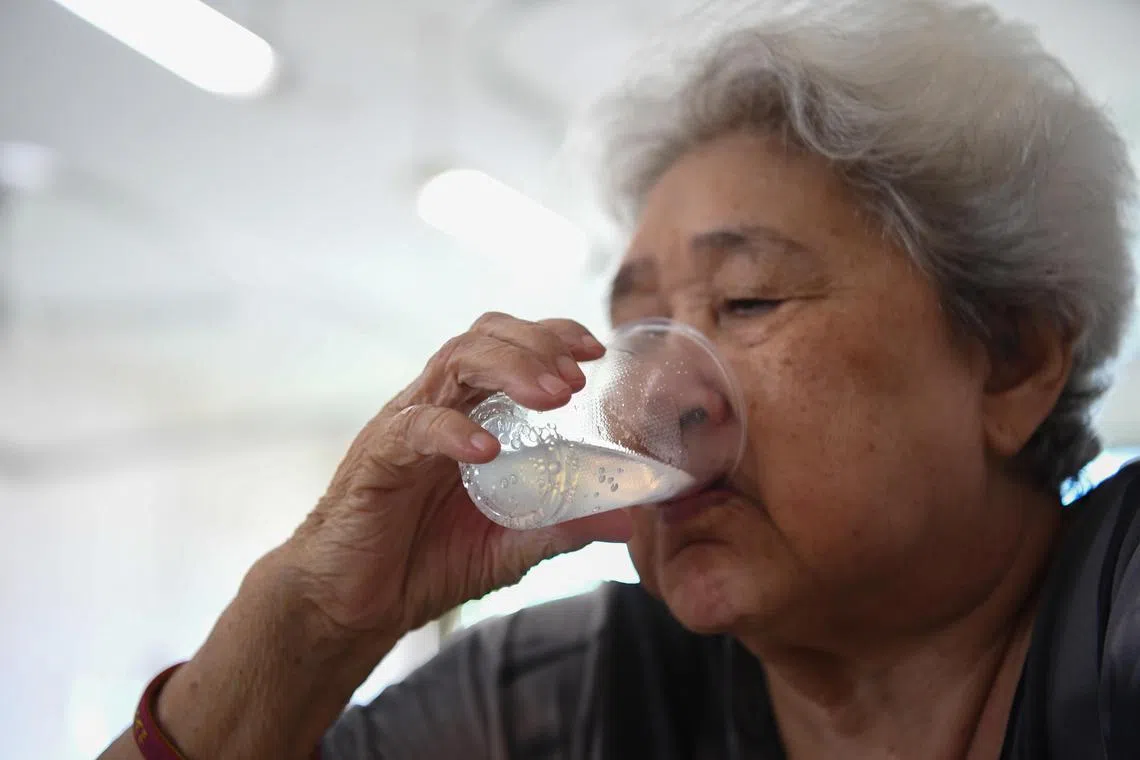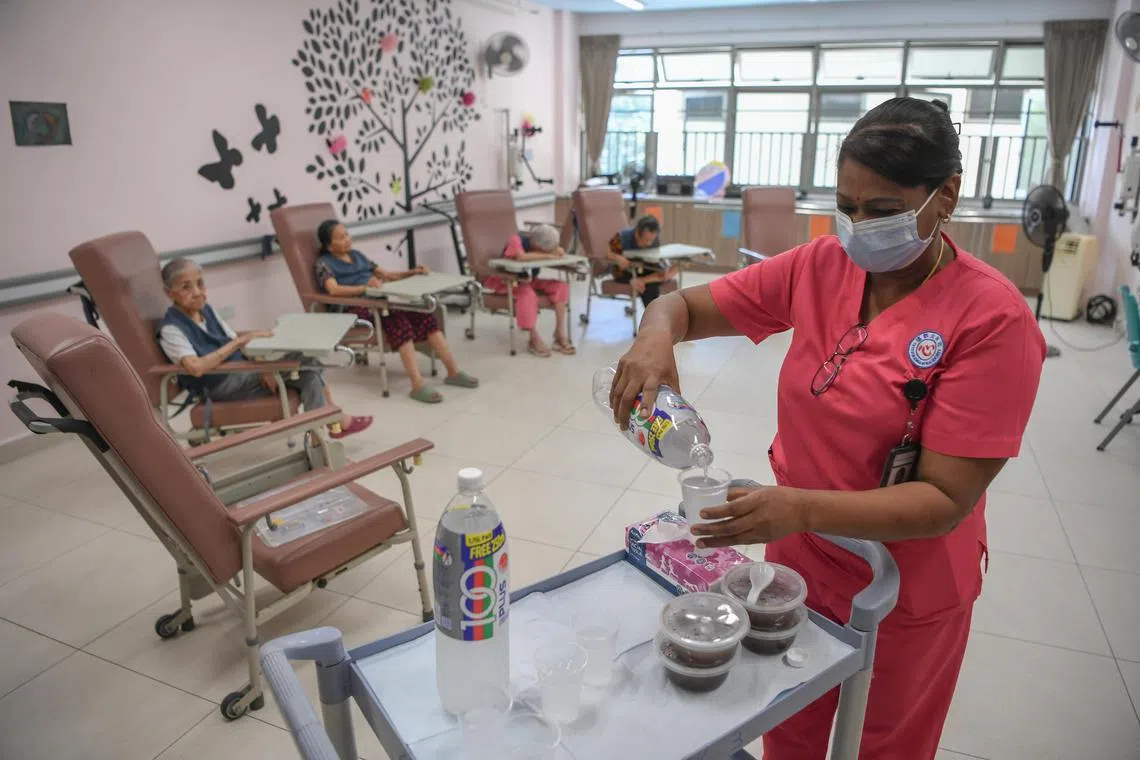Beating the heat a growing challenge for seniors, outdoor workers
Sign up now: Get ST's newsletters delivered to your inbox

An elderly person with heart disease can collapse from heat stress.
ST PHOTO: SHINTARO TAY
Follow topic:
SINGAPORE - In sizzling Singapore, climate scientists and researchers are getting increasingly worried about what the heat is doing to elderly people, outdoor workers, children and other vulnerable groups.
Residents in Housing Board rental flats, for example, generally do not have access to air-conditioning.
To cool off and soothe her heat rash, Madam Tan, who lives in a one-room flat in Bukit Merah, has been taking up to five showers a day since April, when the weather turned hotter and more humid.
Ventilation is limited at home. Despite having fans and a portable air cooler, the heat can be unbearable for the 66-year-old retired human resource professional.
“I had to close one of my windows because hot air was coming in,” said Madam Tan, who declined to reveal her full name.
Singapore has become warmer in recent decades, in part due to climate change, but also because it is now more built-up and buildings trap heat. That can make the annual hot and dry season around the middle of the year especially uncomfortable.
This year’s dry season is expected to last until October because of the El Nino weather pattern,
Climate change could fuel more intense El Ninos, raising the health risks for people in the future.
While heat-related illnesses are often associated with people working or exercising outdoors, experts said more thought should be given to seniors, who can be as much at risk of heat stroke since their bodies are less effective at regulating temperature.
An elderly person with heart disease can collapse from heat stress. This can occur because of oxygen deprivation to the internal organs, when the body draws blood from the organs to the skin to cool itself.
Madam Tan said her neighbour, who is in her 80s, finds it very hard to sleep at night. In June, night-time temperatures stayed stubbornly around 29 deg C on some days.
Madam Tay Sin, 78, another resident of Block 3 Jalan Bukit Merah, had giddy spells on some days.
Associate Professor Jason Lee, director of the Heat Resilience and Performance Centre at the National University of Singapore Yong Loo Lin School of Medicine, suggests: “In the near future, we could have cooling shelters or mobile cooling boxes at housing estates for vulnerable folks.”
A multi-institutional project called Cooling Singapore 2.0
Under one of its research arms, scientists are planning to map future temperature changes in mature housing estates and study the heat-related risks to a greying population, said Cooling Singapore’s principal investigator Winston Chow.
“In pivoting to a more heat-conscious society, we want to provide information to stakeholders so that they can effectively intervene in a warmer Singapore,” added the associate professor of urban climate at the Singapore Management University.
This could be useful for facilities like the Thye Hua Kwan (THK) Nursing Home @ Hougang and Ang Mo Kio-Thye Hua Kwan Hospital, where some patients suffer heat cramps and muscle spasms during hotter periods.
Mr Ardi S. Hardjoe, chief executive of THK Nursing Home, said the patients are treated with cold compresses and motion exercises to ease the cramping.
Mr Ardi and his staff also worry when patients catch the flu or Covid-19 in the hot weather. With weakened immunity, their bodies’ ability to manage heat is further reduced.
“Increased discomfort and slowed recovery, loss of appetite and dehydration could worsen patients’ health conditions amid the heat,” said Mr Ardi.
The heat makes residents with dementia feel more uncomfortable and irritable, and they have to go to the sensory rooms – which provide gentle stimulation in a controlled environment to suit their therapeutic needs – more frequently to calm down, he added.
At the Red Cross Home for the Disabled in Lengkok Bahru, every resident has a water bottle by their bedside, which is monitored by the staff to make sure they stay hydrated. In addition to ceiling and wall fans, there are desk fans by each bed.
Singapore Red Cross director of care services Adrian Lim said that when the temperature exceeds 32 deg C, the air-conditioning that is available in some wards is turned on until dusk.
These days, any outing for residents is to some place with air-conditioning, he added.

Cooling measures at the THK Nursing Home @ Hougang include the use of additional fans and coolers, the use of cooling seating pads and hydration regimes with drinks like 100plus and desserts.
ST PHOTO: SHINTARO TAY
Healthcare workers who have to wear personal protective equipment (PPE) are also at risk of heat strain. They may find it a hassle to remove their N95 masks to drink water, affecting their hydration.
A recent study involving healthcare workers in hazmat suits at the Singapore General Hospital (SGH) found that nurses and doctors are likely to take more risks when they are thermally uncomfortable.
The healthcare workers involved were part of the hospital decontamination station team, which is trained to attend to casualties and survivors exposed to chemical, biological and radiological agents during accidents.
After finishing a two-hour medical drill in their hazmat suits, the employees were asked to do a computerised balloon-pumping task which was used to measure their risk-taking behaviour.
If they “pumped” the balloon too many times, causing it to burst, it meant they were more likely to take risks, which could compromise healthcare outcomes.
The healthcare workers did the drill and experiment twice, once after drinking a sports drink at room temperature and the second time after drinking a slushie of fine ice and liquid, said Dr Sharifah Badriyah, a research fellow with NUS Medicine’s Human Potential Translational Research Programme, who led the experiment.
Drinking ice slushies before physical work is known to be more effective in lowering the body’s core temperature.
Senior consultant R. Ponampalam at SGH’s emergency medicine department said the healthcare workers performed better at the balloon test after they were cooled down with the slushies.
“Heat accumulation in the PPE is compounded when (staff) work in expanded healthcare facilities such as tents or carparks that are converted to care for a surge of patients.
“Staff who are overworked, physically and mentally exhausted are prone to make errors and misjudgments just like in any other work environment… heat strain compounds the matter,” said Associate Professor Ponampalam.
Outdoor workers are also at risk.
On May 13, the temperature hit 37 deg C in Singapore
Despite the intense heat, construction workers were toiling away on a work site, observed Professor Benjamin Horton, director of the Earth Observatory of Singapore at Nanyang Technological University.
“They shouldn’t be. The construction industry needs to change to a practice, in the hottest times of the year, people are not working in the afternoon. Have them start earlier, have a siesta in the afternoon,” said Prof Horton.
According to the Workplace Safety and Health Guidelines, heavy physical labour or work under the sun should be done during the cooler hours of the day.
Prof Lee also heads the NUS-based Project HeatSafe, a research effort investigating the effects of rising heat on the health and productivity of people in South-east Asia.
As part of the project, researchers measured the environmental conditions of 24 worksites in Singapore through 2022 and found that workers were exposed to high heat stress conditions several times in the year.
In May and June, researchers tested some interventions at a construction site in Woodlands that could reduce workers’ heat strain and thermal discomfort.
These included enforcing breaks under the shade, switching to breathable uniforms and providing insulated bottle carry-ons to keep their water cool.
Prof Lee said: “Even though heat stroke is the worst outcome, moderate heat stress exposure for months and years can be damaging. It has led to chronic kidney disease in agricultural workers.”


